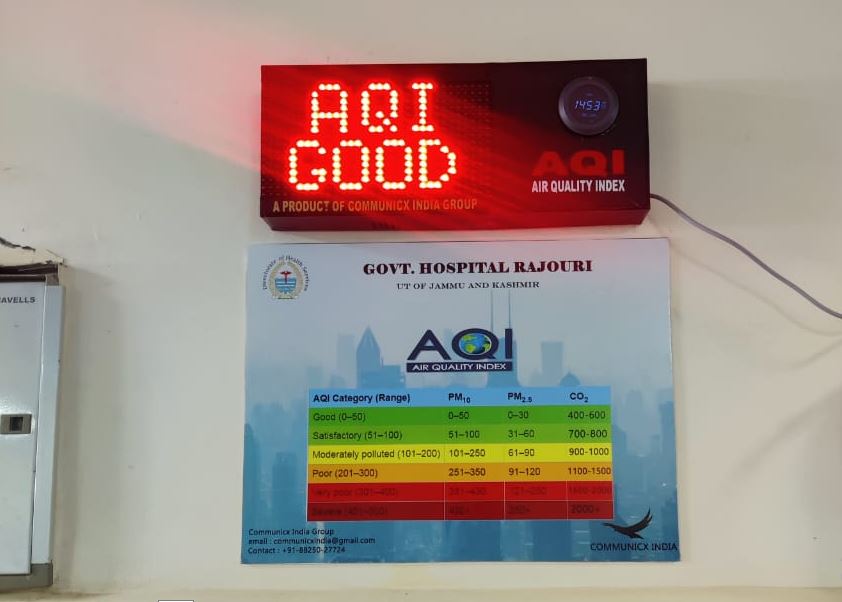New Delhi: Only 12 per cent of India’s 4,041 census cities have air quality monitoring stations with just 200 of them monitoring all six key pollutants, severely limiting the ability to assess and address the extent of pollution across the country, according to a new analysis.
Environmental think tank Centre for Science and Environment (CSE), which conducted the analysis, said nearly 47 per cent of the country’s population remains outside the maximum radius of the air quality monitoring grid.
The study showed 62 per cent of the population is outside the coverage radius of the real-time monitoring network.
This lack of comprehensive monitoring is concerning as compliance with the National Ambient Air Quality Standards and the goals of the National Clean Air Programme (NCAP) rely on accurate and robust monitoring systems.
The NCAP aims for a 20 to 30 per cent reduction in PM2.5 and PM10 concentrations by 2024 with on 2017 as the baseline year.
Anumita Roychowdhury, the executive director of research and advocacy at CSE, emphasised the urgent need for more equitable distribution of monitoring stations and the adoption of hybrid monitoring methods.
She suggested integrating a standardised and certified air sensor network along with satellite-based monitoring to ensure maximum and cost-effective coverage of the population.
By expanding the monitoring network, policymakers can gather essential data to support evidence-based actions against air pollution.
Roychowdhury said the current monitoring network faces challenges related to data quality and completeness. This hampers accurate assessment of air quality trends and compliance with clean air targets.
The study revealed a concentration of monitoring stations in a few major cities, leaving vast regions without adequate monitoring.
Avikal Somvanshi, a senior programme manager at CSE’s urban lab, stressed the need to rectify this disparity by establishing a more comprehensive monitoring network that covers a wider population and habitats.
Such a network would facilitate the implementation of effective clean air action plans, provide vital information to the public about daily risks, and enable the design of emergency responses and long-term strategies, he said.
The CSE analysis considered both manual monitoring under the National Air Quality Monitoring Programme (NAMP) and real-time monitoring under the Continuous Ambient Air Quality Monitoring System (CAAQMS).
It focused primarily on the adequacy and completeness of PM2.5 data, given its significant impact on human health. The study examined data from 883 manual monitoring stations and 409 real-time monitoring stations as of December 31, 2022.
The CSE report said the number of manual monitoring stations has doubled since 2010, reaching 883 stations across 379 cities and towns in 28 states and seven Union territories.
However, the availability of monitoring data is limited, with the discontinuation of station-wise data publication by the Central Pollution Control Board (CPCB) after the NAMP 2020 report.
The number of real-time monitoring stations has witnessed a twenty-fold increase since 2010 with 409 stations in 209 cities and towns across 27 states and four Union territories.
However, the accuracy and reliability of real-time data collection are compromised due to the non-reporting of data from certain stations over the years.
For example, several stations, including those in Airoli in Navi Mumbai, Bandra in Mumbai, PWD Grounds in Vijayawada and Nishant Ganj in Lucknow, have not reported any monitoring data in recent years.
The analysis also revealed that only 476 out of 4,041 cities and towns in India have air quality monitoring stations.
It found that 267 cities have manual stations, while 98 cities have only real-time stations and 111 have both types of stations. This indicates a significant gap in monitoring infrastructure, particularly in smaller towns and rural areas.
Also, the current air quality monitoring network falls far short of the recommended guidelines.
As per the standards, the minimum number of monitoring stations should correspond to the population size, pollutant levels, and type of city or town. However, the existing network only meets sic to eight per cent of the minimum recommended capacity. This inadequacy poses a significant challenge to accurately assess compliance with clean air targets and identify areas of non-attainment.
The population coverage by the monitoring grid is also deeply insufficient. Around 47 per cent of the Indian population, or around 655 million people, live outside the 50-kilometre radius of the air quality monitoring stations, which means they lack the immediate benefits of real-time monitoring.
Only 4 per cent of the population, or around 50 million people, live within the two-kilometre radius of monitoring stations while 15 per cent reside within a two to 10 kilometre radius and around 34 per cent live within a 10-50 kilometre radius.
Among the states and Union Territories, only Chandigarh, Delhi and Goa have achieved full population coverage under the combined monitoring network.
In Delhi, 26 per cent of the population resides within a two-kilometre radius of the city’s 40 real-time and 10 manual monitoring stations.
Chandigarh has the second-best coverage, with 40 per cent of its population living within the two-kilometre radius of its eight manual and real-time monitoring stations. However, no other state or Union Territory has achieved over 90 per cent population coverage within the 50-kilometre radius.
The inadequate monitoring coverage has serious implications for public health and effective policymaking.
Limited air quality monitoring makes it challenging to identify non-attainment areas and evaluate the impact of clean air actions. It also impedes the inclusion of more harmful pollutants such as PM2.5 and ozone under the National Clean Air Programme, the CSE said.
PTI

